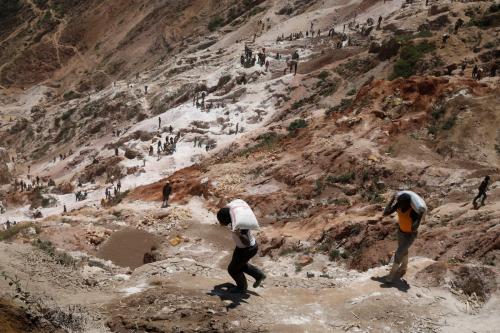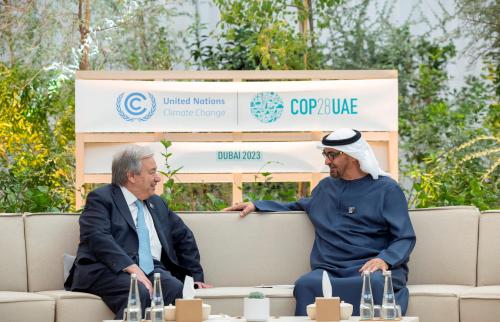Over 30 years ago, the World Bank began to develop policies to safeguard the rights of those displaced by Bank-financed development projects. The safeguard policy on involuntary resettlement initiated in turn a series of follow up policies designed to safeguard other groups and sectors affected by Bank investments, including the environment and indigenous people. Since its adoption in 1980, the Bank’s operational policy on involuntary resettlement has been revised and strengthened in several stages, most recently in 2001. The regional development banks – African Development Bank, Asian Development Bank, InterAmerican Development Bank, the European Bank for Reconstruction and Development, and the International Finance Corporation (IFC) – have all followed the World Bank’s lead and developed policies for involuntary resettlement cause by development projects financed by these multilateral banks.
While the policies are complex, the basic thrust of these safeguard policies on involuntary resettlement has been to affirm:
- Involuntary resettlement should be avoided where feasible.
- Where it is not feasible to avoid resettlement, the scale of displacement should be minimized and resettlement activities should be conceived and executed as full-fledged sustainable development programs on their own relying on commensurate financing l and informed participation with the populations to be displaced.
- Displaced persons should be assisted to improve, or at least restore their livelihoods and living standards to levels they enjoyed before the displacement.[1]
Even with these safeguards policies, people displaced by development projects risk – and very large numbers have actually experienced – a sharp decline in their standards of living.[2] Michael Cernea’s Impoverishment Risks and Reconstruction model identifies the most common and fundamental risks of such displacement and resettlement processes: landlessness, joblessness, homelessness, marginalization, food insecurity, increased morbidity and mortality, loss of access to common property, and social disintegration.[3] If insufficiently addressed, these embedded risks convert into actual processes of massive impoverishment. And particular groups may be especially affected, as noted in the World Bank’s Operational Policy: “Bank experience has shown that resettlement of indigenous people with traditional land-based modes of production is particularly complex and may have significant adverse impacts on their identity and cultural survival.” (OP 4.12, para.9)
These safeguards policies are an important instrument to minimize and overcome the harm suffered by those displaced by development projects. It should be noted, however, that there have always been problems in the implementation of these policies due to the evasive implementation by borrowers or the incomplete application by World Bank staff. The Bank’s interest in researching the impacts of compulsory resettlement triggered by its projects has been sporadic. In particular, World Bank has not carried out and published a comprehensive evaluation of the displacements caused by its massive project portfolio for the last 20 years. The last full resettlement portfolio review was conducted two decades ago, in 1993-1994. In2010, with the approval of the Bank’s Board, the Bank’s Independent Evaluation Group (IEG) undertook a broad review on how not only the policy on involuntary resettlement, but all social safeguards policies have or have not been implemented. Reporting on its findings, the Independent Evaluation Group (IEG) publicly faulted World Bank management for not even keeping basic statistics of the number of people displaced and not making such statistics available for evaluation.[4] Similar analytical syntheses are missing from other multilateral development agencies, such as, IADB and EBRD. There is a strong sense within the community of resettlement specialists that successful cases are the exception, not the norm. In sum, projects that are predicated on land expropriation and involuntary resettlement are not only forcibly uprooted large numbers of people, but leaving them impoverished, disenfranchised, disempowered, and in many other aspects worse off than before the Bank-financed project.
While the Bank’s safeguard policies were in need of review and many argued for a more explicit incorporation of human rights language into the policies, the Bank took a different approach. The Bank’s team tasked with “reviewing and updating” eliminated many robust and indispensable parts of the revised existing safeguards, watered down other parts, and failed to incorporate important lessons from the Bank’s own experiences as well as relevant and important new knowledge from social, economic, and environmental sciences.
At the end of July 2014, the Bank published a “draft” of the revised safeguards’ policies which were not based on consultation with civil society organizations (CSOs) as had been promised. Rather the newly proposed policies were held close and stamped “strictly confidential.” The numerous CSOs and NGOs involved for two years in what they thought was a consultative process learned only from a leak about plans by Bank management for proposals to the Bank’s Board and its Committee for Development Effectiveness (CODE). Because of this secrecy, the Bank’s Board and the CODE itself were not made aware of the civil society’s views about the Environmental and Social Safeguards draft policy, before CODE had to decide about endorsing and releasing it for a new round of “consultation.”
As is well known, the process shapes the product. These bizarre distortions in the way the World Bank conducted what should have been a transparent process of genuine consultation resulted in some deep flaws of the product as manifest in the current draft ESS.
The backlash was inevitable, strong, and broad, coming from an extensive array of constituencies:’ from CSOs, NGOs, and various other groups representing populations adversely affected by Bank financed projects, professional communities , all the way to various organisms of the United Nations. More than 300 civil society organizations issued a statement opposing the Bank’s plans and at World Bank meetings in mid-October 2014, civil society organizations walked out of a World Bank ‘consultative meeting’ on the revised policies. The statement argued that the consultative process had been inadequate and that the safeguards were being undercut even at a time when the Bank is seeking to expand its lending to riskier infrastructure and mega-project schemes. While the Review and Update exercise was expected to strengthen the provisions of existing policies, instead the policies themselves were redrafted in a way that weakened them. The civil society statement notes that the revised draft “eliminates the fundamental development objective of the resettlement policy and the key measures essential to preventing impoverishment and protecting the rights of people uprooted from their homes, lands, productive activities and jobs to make way for Bank projects.”[5] Not only did the revised policy not strengthen protections for displaced people, but each of its “standards” represents a backwards step in comparison to existing policies. According to the draft revised policies the Bank could now finance projects which would displace people without requiring a sound reconstruction plan and budget to “ensure adequate compensation, sound physical resettlement, economic recovery and improvement.” Moreover, the application of some safeguards policies would now become optional. Although the regional development banks have not – so far – begun to take actions to weaken their own safeguard policies, there is fear that they will follow the Bank’s lead.
Just as humanitarian response to internally displaced persons seems to be sliding backward, so too the actions of development agencies – or at least the World Bank – seem to be reversing gains made over the past three decades.
[1] This is from the Introduction by James Wolfensohn to Operational Policies OP4.12 Involuntary Resettlement, New York: World Bank Operational Manual, p. 1.
[2] See for example, Michael M. Cernea, “Compensation and Investment in Resettlement: Theory, Practice, Pitfalls, and Needed Policy Reform” in vol. Compensation in Resettlement: Theory, Pitfalls, and Needed Policy Reform, ed. by M. Cernea and H.M. Mathur, Oxford: Oxford Univ. Press 2008, pp. 15-98; T. Scudder, The Future of Large Dams: Dealing with Social, Environmental, Institutional and Political Costs, London and Sterling VA: Earthscan, 2005;
[3] Michael M. Cernea “Risks, Safeguards and Reconstruction: A Model for Population Displacement and Resettlement,” in M. Cernea and McDowell, eds., Risks and Reconstruction: Experiences of Resettlers and Refugees, Washington, DC: World Bank, 2000, pp. 11-55. and Michael Cernea, Public Policy Responses to Development-Induced Population Displacements, Washington, DC: World Bank Reprint Series: Number 479, 1996
[4] Independent Evaluation Group, “Safeguards and Sustainability Policies in a Changing World: An Independent Evaluation of World Bank Group Experience”. Washington DC: World Bank. 2010, p. 21. The report indicates verbatim that: “IEG was unable to obtain the magnitude of project-induced involuntary resettlement in the portfolio from WB sources and made a special effort to estimate this magnitude from the review sample.” The resulting estimates, however, have been based on a small sample and have been met with deep skepticism by many resettlement researchers. The IEG report itself has not explained why the World Bank had stopped for many years keeping necessary data and statistics of the results of its projects on such a sensitive issue, although more than three years have already passed from the date of the IEG report to the writing of the present paper. Astonishingly, the World Bank Senior Management has not taken an interest in producing for itself, as well as for the public, the bodies of data signaled by IEG as missing and indispensable. Nor has the Bank’s Management accounted for taking an action-response to its IEG’s sharp criticisms, of the quality, or for whether it took specific corrective measures to overcome the multiple weaknesses signaled by the IEG report.
[5] Civil society statement, p. 2



Commentary
Is the World Bank Retreating from Protecting People Displaced by its Policies?
November 24, 2014